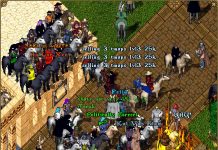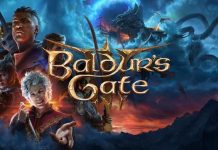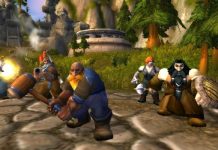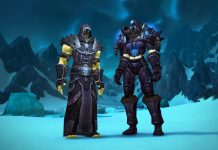Games that style themselves as Massive Online Battle Arenas (MOBAs) have become a dime-a-dozen across the past few years as League of Legends and DOTA 2 have become extremely popular. Dawngate is one such MOBA published by Electronic Arts and developed by Waystone Games for Microsoft Windows PCs. It is a free-to-play game supported by microtransactions and follows the standard MOBA core gameplay while using the tagline, “Break the meta.”
Dawngate went into closed beta May 24, 2013 and then into open beta on May 19, 2014. It has been in open beta since and shows a growing community.
As a game, Dawngate does very little to “break the meta,” and is in fact a staid-and-true-MOBA. It has a multitude of features in common with the regular MOBA game—lanes, towers, creeps, heroes, etc.—and although it has some separate approaches they’re more variations on the same theme rather than anything altogether new.
The graphics, animations, and artwork of the game are superb, and the game mechanics play without lag or stutter, and it’s quite easy to get into. Once the initial core game learning curve is over, Dawngate plays with all the flare of a proper MOBA game.
Where Dawngate really fails is that it’s subject to the same sort of crummy, caustic players that MOBAs are well known for. The sad irony is that this reinforcement of toxic players happened after a game where the players discussed that Dawngate did not have a toxic community.
Graphics and audio: Waystone Games did a good job building an attractive game
Much like many MOBAs on the market (e.g. League of Legends) Dawngate uses a separate windowed matchmaking app that then launches the main full-screen game once a match has been put together and the heroes locked in.
The UI is clean, concise–and clicky, elements click audibly when the mouse moves over them. Both the launcher and the game itself do a great job of displaying what’s happening on the screen and provide little resistance for understanding the elements of the UI—this is excellent in a game such as Dawngate where much of the entry to the game is understanding how to get things done.
Of course, a lot of the nature of the UI is easy to use because it’s very similar to other MOBAs on the market; but this is not a mark against the game, as matching the rest of the genre is good for players coming from similar games. The UI is also functional and intuitive for players who do not understand MOBAs.
In game, the heroes have excellent animations—known as Shapers in game parlance—and their attacks each have suitably good looking effects and sounds to go with them. Mousing over a particular power gives an area of effect (or targeting range) as well as an idea of how to use it. The tooltips are readable and readily digestible, especially good for anyone using a new hero they’re unfamiliar with.
Due to the unique nature of many of the powers used by heroes, with the sounds and FX that come with them, it’s easy to identify when an enemy hero has burned their ultimate or other certain powers. As a result, there’s a certain amount of strategy in encounters for catching foes when their abilities are on cooldown in order to defeat them.
The music in both the game and the matchmaking screen is quite pleasant and good listening. To their credit, Waystone Games added a “mute music” button to the matchmaking app for anyone who really wanted to listen to something else while waiting.
Gameplay: Standard MOBA fare with some interesting highlights
Anyone who has played a MOBA before already knows the core gameplay of Dawngate—it does not actually deviate very much at all. Bird’s-eye-view of a top-down battlefield, lanes, creeps, towers, click-to-move, heroes with three powers and an ultimate, and items bought from the store. Where the game diverges a little bit is where I will focus parts of this review. The game has a total of 32 heroes (called Shapers) available for play.
Along with the standard powers are selected powers (1-3) that get added every 10 levels that allow for more damage, escape, or utility such as weakening enemy heroes or slowing them down. All of these powers seem to have a five minute cooldown so they need be used sparingly. The favorite level 10 power I put on the 1 hotkey happened to be an escape, or “blink” enabling me to get out of enemy range quickly.
The primary map is a two lane affair with towers running up from the bottom to top with a massive jungle in between and Spirit Wells on the sides. Soul wells are a sort of resource generation that produce the currency used to buy items.
When opening a new game, players get a chance to choose what’s called “roles.” These roles are Gladiator—good for people who want to farm lane minions, Tactician—a support role for people who set up kills, Hunter—good for people who want to kill unaligned mobs in the jungle, and Predator—for aggressive players who want to hunt down and kill enemy heroes. Picking a role that suits expected style of play is
It should be noted that Dawngate has a novel way of approaching player community toxicity. At the end of every match players are given the opportunity to give karma to allies and foes. This is a toggle selected while looking at the final battle metrics and getting a lot of karma leads to increased earnings of the various boons and currencies of the game.
In the final game that I played, which my team won (and everyone was actually pleasant, see below) offers for “k4a” were made before the end. This means “karma for all” and although I did not know what it meant at the time, I had reason to make sure everyone, friend and foe alike, got karma.
Community: Made a bad first impression much worse
Before getting into my review of the terrible first impression I received of Dawngate’s community, I’d like to say that during my review session I did meet one thoughtful, helpful, and actually worthwhile person. This meeting, however, was offset rapidly by the next game that I played where two of my own teammates were actively hostile and proved incapable of communicating or addressing my lack of knowledge of the game.
My first impressions of Dawngate is that it really falls down on community in general and is host to a swarm of pestilence and toxic obnoxious players. MOBAs as a genre already have a very bad reputation for poor communication and bad players, to the extent that League of Legends has received numerous essays discussing the general ambient scumbggery level.
During my second game I met two such obnoxious buffoons: Sync_Override and DigitalRemoval. As I said above, both on my team and both odious individuals.
Sync_Override played a bow-wielding character and was tasked in the lane I was in. This player alternated between ordering me not to attack the creeps (needed to gain XP) and then berating me for fading back to avoid attacking them. In several instances he made demands and then did not explain when I asked him what he meant. Everything Sync said had to be explained by a different helpful teammate. He ended the game calling me “bad” and laughing at mistakes made because it was my second battle.
Then walks in DigitalRemoval, who whereupon saying I did something wrong early game I said, “You mean that thing I asked about?” DR responded with, “you didn’t ask anything.” The best part of this response is that my last question was still visible in the chat window a mere 4 lines earlier. They finally replied with “lol”, “ok dude” to my frustration.
Two unhelpful, dishonest teammates and eventually we lost the match by way of surrender.
Certainly compared to the mythical level of bad behavior displayed by League of Legends players this is diminishingly weak; however, this is not the way you want your brand new players treated by the community. Abuse and neglect for not understanding the social mechanics; ignoring them when they ask questions based on criticism; and then berating them for being “bad” when you fail to communicate team needs effectively.
Freemium: Microtransactions used to unlock heroes and skins
In Dawngate the heroes are called Shapers and there are a set of free ones that everyone can use (very similar to League of Legends) new heroes must be unlocked using the premium currency.
The freemium currency in Dawngate is called Destiny, while the premium currency is Waypoints. Destiny can be used to buy a lot of various items from the matchmaking app (also used as the lobby.) All of the Shapers are available for Destiny or Waypoints, often the difference is around 3:1. For example, Zeri (a painter) can be bought for 685 Waypoints (approx. $7.61) or 1800 Destiny. As Destiny is earned from playing games, it could take numerous hours of play to earn a Shaper.
Waypoints sell at 450 for $5 all the way up to 5,200 for $50; a rate of about 1.1c to 0.96c. The cost does go down slightly when buying in bulk.
Other items that can be bought for the most part can only be bought with Waypoints. Skins for Shapers, for example, cost between 585 and 785 waypoints. Announcers, a voice pack to listen to during a match, run 885 Waypoints. Skins for wards cost 485 Waypoints.
It’s not uncommon for a game to put microtransactions onto elements of the game that primarily provide aesthetic changes—which is exactly what Shaper skins, Ward skins, and Announcers happen to be.
The game is very quick to suggest that you can give them money. Right out the gate (after installing and logging in the first time) I was greeted with a screen offering to sell me the premium currency.
Conclusion: Dawngate does not “Break the meta,” it reinforces it
Dawngate does not deviate far from nor really innovate on the MOBA genre to any extent that makes it anything more or less than a MOBA—this is neither here nor there because the genre is already heavily defined by the big, popular games such as League of Legends and DOTA 2. It’s not necessary for the game to be stand-out-amazing to stand up.
The systems that the game uses will be familiar to MOBA players and it has enough differences to mean that it might be a good space for anyone who wants to escape from playing too much LoL or DOTA 2, if they’re into a vacation spot.
However, as I said above, like most MOBA gaming experiences, Dawngate has its fair share of a rotten population and this is a problem. The MOBA gaming scene easily casts a heavy umbra over the entire multiplayer gaming space—even moreso than what people think about games on services such as Xbox Live or even MMO gaming communities such as those of World of Warcraft. A player seeking a comfortable, actively helpful community for new players will likely not find it amidst the rash of hostility I found in Dawngate.
Keeping that in mind, new players will likely need to dig through this blight on the community in order to enjoy the underlying game. As with any MOBA, user experience may change during play; bring friends and keep the immature masses at arms length.




















Watching this at the time was painful and frustrating. That first game was so promising… I literally could not believe it. It’s things like these that drive me away from competitive gaming, it’s just not worth it in my opinion. Regardless if it’s targeted at me or even someone I don’t know, I hate reading it, I find it super frustrating and the worse it gets the less I care about the game.
I understand it’s a hard issue to tackle but at the same time it seems companies aren’t taking it seriously. Case and point a real example from LoL:
” Rodriguez has been reported in over 30% of the games he played, with nearly 60% of those reports being for Offensive Language, Negative Attitude, and Verbal Abuse. During this period, his harassment score rose to be within the top 1% of all players on EUW.(..).Despite previous punishments for his toxicity, Rodriguez’s behavior has shown no improvement over the past months, even after his account became Chat Restricted. ”
Ruling – Suspended from Professional Competition through the end of 2014.
That’s it, suspended from competition. Which is a great start but it seems he wasn’t getting banned from the game itself (maybe he did I don’t know) and he’ll be welcomed back to competition at the end of 2014. This from someone Riot themselves labelled “extremely toxic”. His offenses include but was not limited to “in game harassment, verbal abuse, and continual use of racial slurs” … frankly you can be arrested for doing stuff like that in public.
Now I’m know this is about Dawngate and I’m going on about LoL here but LoL is the leader in the MOBA genre it has to set the standards and frankly I don’t think it set them very high. It’s not encouraging as if the leader doesn’t crack down how can we expect everyone else too as well.
Any case it’s not a problem that’s just gonna go away, it’s certainly not exaggerated either as even the most devoted lovers of MOBA’s will tell you toxic players exist.and can be problematic. I’d really like to see the big MOBA Developers come together and really try to make a run at stopping it or at the very least devote more time to creative solutions to stop it.
Dawngate is really solid MOBA, but it’s too hard for any Moba to stand out atm.
Ye, its great MOBA, but so parts of the map(jungle, etc.) are kinda same like in League and DotA2. But still this game seems to be really nice.
I support that kind of MOBA games, this seems pretty cool 😀
great moba but its something like …. idk – seen 🙁
Another moba , didn’t like the maps so I gave up.
Today I was reviewing only decent game,lol. This moba would be totally okay if there aren’t Dota,LoL,HoTs,Smite. But,you cant compare this game to those,because it is 5 levels below those mobas. I wouldn’t suggest you this game,and I’m giving one star(because I have to,if there is a zero star,i would give that grade :/ )
Dawngate is a decent multiplayer online battle arena(moba) video game which is developed by Waystone Games.In gameplay you got you 5 men team and you have got to do objects and destroy enemy guardian,gameplay is interesting and grahpic is solid,I recommend this game everybody